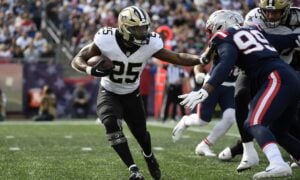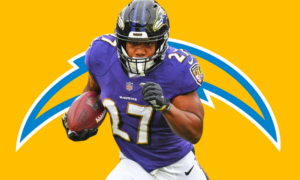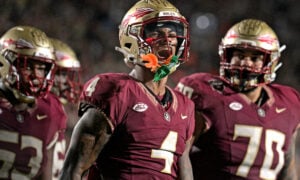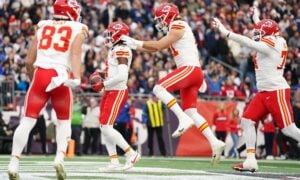Keeping Dynasty Weird: The League with no Name
Throughout my time in the fantasy football community and at Dynasty League Football, I’ve always thought of Ryan McDowell as my “Dynasty Dad”. With the many crazy league formats Ryan has created and participated in, I’ve always wanted to follow in those footsteps. I’ve been commissioning dynasty leagues over the last three years with some less-than-normal ideas like Devy Auctions or Best Ball Dynasty leagues, but this off-season I set out to create and fill my craziest league idea yet.
The idea was spawned by asking “how fun would it be to own the entire NFC East? Just imagine a roster of Odell Beckham Jr., Dez Bryant, and Jordan Reed.” it may sound like a random idea, but that’s how most crazy dynasty league ideas originate. The first step was figuring out how something like that would work. There are only eight NFL divisions and dynasty league are traditionally 12+ teams, so that seemed a bit shallow and it would lack the competition aspect of a draft or auction if everyone just started with all of the players in their division.
[am4show have=’g1;’ guest_error=’sub_message’ user_error=’sub_message’ ]
In order to add some competition, I decided to integrate the eight NFL divisions with the five major college conferences (SEC, Big 10, Big 12, Pac 12, ACC) and a “field” conference to cover all of the players not in a major college conference. This added up to 14 teams for the league, coincidentally my favorite league size. It adds value to quarterback in 1QB, and it makes it more difficult to build a “super team”, while also not making it impossible to rebuild (which can be the case in 16+ teamers).
The concept was that NFL Division teams would draft against College Division teams for the players that they had in common. For example, the NFC East and SEC would choose between Beckham, Reed and Jordan Matthews among others. I quickly discovered that a draft with this format would be incredibly slanted towards the teams with the first picks and even with serpentine style drafting, there wouldn’t be a fair way of assigning which teams got the first picks in their respective drafts, in this initial thought, it would’ve been 48 head to head drafts, which sounds like a ton of fun, but alas that idea was nixed.
So then I moved on to the idea of moving to the auction format where each player would be a head to head auction battle between the two players with their affiliation. Outside of the conference/division aspect, it is a fairly normal league – start 1 QB, 1 RB, 1 WR, 1 TE and 4 regular flex, and it has regular 1 PPR scoring. I tinkered with the idea of only allowing owners to own players with their affiliation, but I felt that that would make for minimal trades as owners would have likely already won players they wanted in startup or rookie auctions. So, in order to allow for maximum activity in the league, the affiliations only come into place in the startup and rookie auctions, they have no impact on trades or the waiver wire.
Once the 12 month journey of finding 14 owners willing to participate in such a crazy league was finalized, it was time to decide which owners would have which conference or division. For this, we did a simple randomized draft order from a third party site, which in retrospect wasn’t the fairest way of going about things, but it was the best idea I had to be able to start the league immediately.
There was one proposal during the auction that I would have implemented had the idea come about before the division/conference draft began. The idea was to implement starting rookie dollars weighted based on where in the division draft your pick was, for example 14th pick would’ve gotten $320 rookie to start the league while the first pick would have around 100, and the higher the pick, the cheaper the stipend.
The division/conference draft took place in March and it went as follows:
1. NFC South
2. SEC
3. The Field
4. ACC
5. AFC South
6. NFC East
7. Big 10
8. AFC West
9. AFC East
10. AFC North
11. NFC North
12. NFC West
13. PAC 12
14. Big 12
While the draft certainly had some strategy involved, many owners ranking players and divisions/conferences by which player they were eligible for, there was also bias that would seep, whether it came from college or NFL fandom. Drafters had comments like “since I previously attended the University of Florida and have always been a fan of big-time college football, I’m going to have to go with the SEC!” and “not being a homer may prove to be difficult, but the AFC South looks good to me here”.
Once the division/conference draft was finished, we were ready to get going on the startup. During the startup auction, it actually wasn’t too different from a normal startup. The one intriguing and frustrating aspect was recognized immediately. On the first day of the startup, as Bryant was at $2/$400 with just moments to go on the auction clock, he was bid up by the opposing team to $46. While cheaper than most in the league voxer chat would’ve liked to see, it wasn’t the possible league-ender that $2 for Bryant could’ve been.
The one trend that I saw, and something that was also part of my strategy was to not nominate the top players in my division early on. I hoped other teams would spend their money on players I wasn’t eligible to bid on, and I could get my top players for cheaper. As the AFC East team, it didn’t exactly work out as Brandin Cooks and Rob Gronkowski were nominated while I was nominating Tom Brady and Tyrod Taylor. As the startup came to a close, there was one thing the SEC team pointed out that other divisions/conferences didn’t have sympathy for. The SEC owner had so many quality players to bid on, he felt obligated to price enforce so that SEC players didn’t go for pennies on the dollar, but he also had to be sure to have money left toward the end of the auction to ensure that the last of the top players didn’t go for a $1. For example, if SEC had spent all of their dollars before Todd Gurley went on the board, NFC West would’ve won the running back for only a $1.
Since the start of startup auction in late March, the 14 owners in the league have made a combined 36 trades. For the most part, the trades are similar to those that you would see in a normal dynasty league, but there are a few exceptions. The first thing being quarterback trade value seemed a bit inflated in the league, with trades like:
Matt Ryan and the 2.03 (in rookie money value) for Demaryius Thomas and 3.13
Sam Bradford and 1.09 for Matthew Stafford
Randall Cobb/2018 first round pick for Marcus Mariota
I hypothesize the reason for this bump in quarterback trade value is every NFL division only has four (in some cases five) total quarterbacks worth a roster spot and a couple of college conferences have even less than that. With minimal choices at the position, some just opted to spend trade capital on the quarterback in order to not have to worry about it during the startup auction or even after.
One of the intriguing parts of the rookie auction in this format is that eight of 14 teams won’t know which players they will be eligible to bid on until draft weekend. So, during the startup, NFL divisions were bidding on rookie money that they didn’t know whether it’d be able to help them get Corey Davis or if their best asset to bid on would be Zay Jones. College divisions were at a slight advantage from the perspective that they’ve been able to buy and sell rookie dollars knowing which players they’d be eligible to bid on.
So, post draft, there are two ways this causes trades. For the teams at the lower end of the dollar spectrum, if they end up with the ability to bid on a top player, they will want to try and trade rookie money to be able to win him. Other teams will be wanting to trade them rookie money to ensure the other team with bidding rights on the player won’t win them for $1 or nearly free.
As of May 9th, four trades involving 2017 rookie money have occurred since draft weekend and it’s likely a few more should happen before the rookie auction in mid-May. Many people are excited to draft immediately following the NFL, but with this format it is important to have a period of time for NFL division to be able to buy or sell rookie money based on finding out which players they are eligible to bid on.
This league will be an intriguing one to participate in and follow along with, but the one thing that I’ve found as commissioner is that a league like this requires understanding and flexible owners. A number of questionable things will happen in the first few years of the league, like determining what to do with RFAs and UFAs during the auctions, or which college affiliation Dorial Green-Beckham should have since he last played at Missouri but last attended school at Oklahoma.
If you are interested in reading the full bylaws for the league, they can be found here, and an in-depth discussion on the league in podcast form can be found here on the Fantasy Insanity Podcast with John Bosch.
[/am4show]
- Dynasty Commish Calendar: August - August 5, 2023
- Dynasty Commish Calendar: June - June 9, 2023
- Dynasty Commish Calendar: May - May 3, 2023


































































